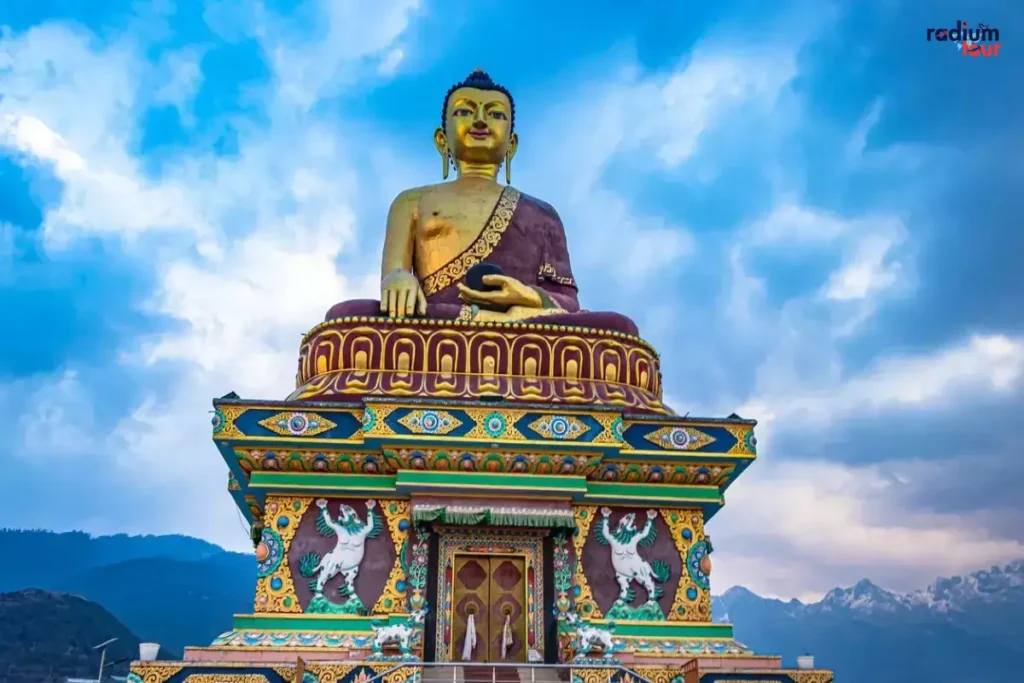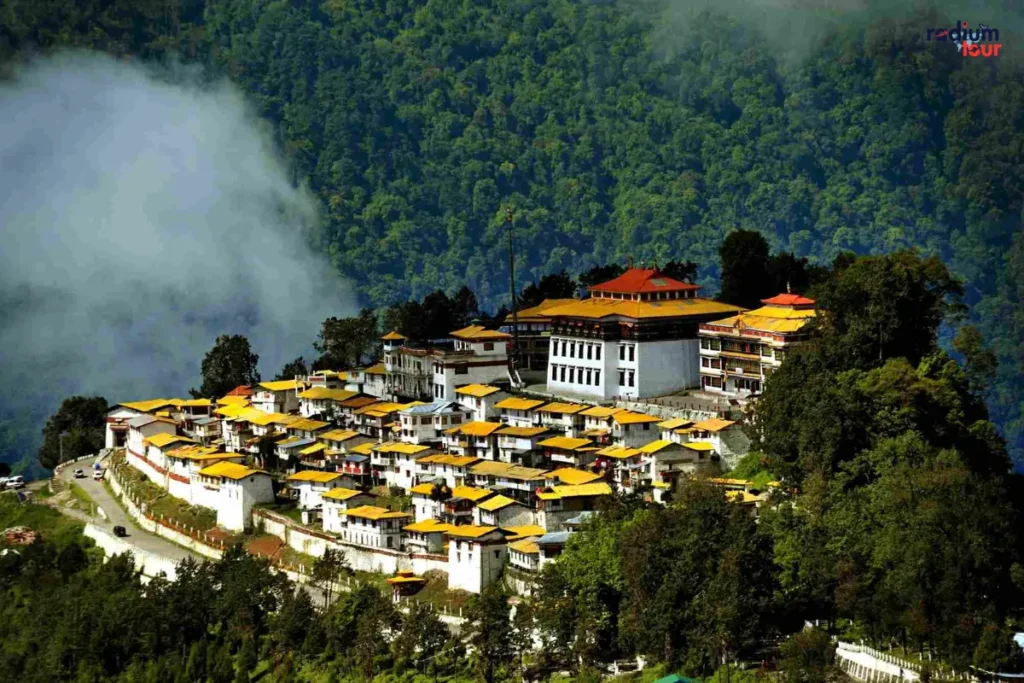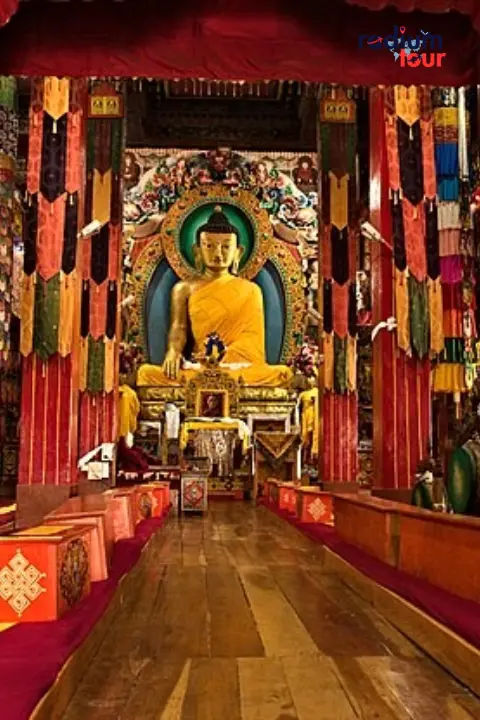Tawang
The Tawang Monastery, formerly known as Galden Namgyal Lhatse, is nestled away in the picturesque town of Tawang and is a sacred place for Buddhists worldwide. It is a tribute to the region’s rich spiritual past and the biggest Buddhist monastery in all of India.
Founded by Mera Lama in the 17th century, the monastery is situated at a remarkable elevation of approximately 10,000 feet, offering visitors a breathtaking panoramic view of the valley below, framed by majestic peaks resembling snow crowns. The air of the monastery has a distinct feeling of serenity and spiritual resonance because of this elevation.
Galden Namgyal Lhatse has become a sanctuary for seekers of spiritual enlightenment and a hub for Buddhist practice. Its architectural magnificence, with intricate detailing and vibrant colors, showcases the devotion and skill of the craftsmen who built it. The monastery’s significance transcends its architectural grandeur; it serves as a spiritual epicenter, hosting various religious ceremonies and events that draw devotees from far and wide.
The Tawang Monastery stands as a guardian of cultural and religious heritage, forwarding a deep sense of community and belonging among its interpreters. Pilgrims and tourists also are portrayed not only to its spiritual holiness but also to the admiration- inspiring natural beauty that envelops this sacred place. The serene backdrop of snow-clad peaks and the crisp mountain air further enhance the sense of divine connection experienced by visitors.
Visiting the Tawang Monastery isn’t just a journey; it’s a transformative experience that allows one to be involved in the spiritual heritage of the region while being cradled in the lap of nature’s majesty. Each visit leaves an unforgettable mark on the heart, inviting tourists to return and seek solace in its hallowed halls time and again.

The History and Significance of Tawang Monastery
Beyond its spiritual essence, the Tawang Monastery boasts a remarkable history, standing as a resilient bastion against the Chinese army’s incursion during the Indo-China War of 1962. This profound resilience earned it a place of honor in the annals of regional history.
Also, the monastery’s legacy extends to the propagation of Buddhism in India. As an important center for Buddhist Studies, it has led significantly to the advancement of a thorough knowledge of Buddhist philosophy and practices among academics and applicants worldwide as well as within the original community.
This place of rest has not only given comfort to the faithful in difficult times, but it has also served as a community-wide symbol of resiliency. It has witnessed eras of change and turmoil, emerging each time as a beacon of hope and continuity.
Today, the Tawang Monastery stands as a vigorous force, not exactly within the realm of religion, but also as a pillar of the community’s artistic identity. Its significance stretches far beyond the spiritual, influencing the socio-cultural fabric of the region. As a repository of wisdom and a haven of peace, it continues to inspire generations, ensuring that the legacy of the Tawang Monastery endures for posterity.
Highlights of the Tawang Monastery
The centerpiece of the Tawang Monastery is its grand three-story assembly hall, adorned with intricate paintings and murals depicting vivid scenes from Buddhist traditions and mythology. This hall serves as the heart of daily prayers and spiritual ceremonies conducted by the devoted monks.

An awe-inspiring 28-foot-tall gilded statue of Lord Buddha graces the monastery, standing as the largest among a myriad of Buddha statues within the complex. Crafted from bronze, this statue stands as a testament to the exceptional craftsmanship of local artisans.
The Tawang Monastery offers visitors a unique glimpse into the daily lives of the residing monks. Guests have the opportunity to participate in both morning and evening prayer sessions. Additionally, immersing oneself in the vibrant festivals celebrated here is an essential part of any Tawang itinerary:
- Losar Festival (February or March): This marks the Tibetan New Year and spans three days. It involves special prayers, along with the mesmerizing mask dances known as ‘Cham.’
- Torgya Festival (January): Dedicated to the deity Dorje Pakmo, this festival extends for three days. Monks engage in chanting mantras, sacred dances, and prayers to dispel malevolent forces and usher in peace and prosperity.
- Gaden Ngamchoe Festival (December): Commemorating the passing of Je Tsongkhapa, the founder of the Gelugpa sect of Buddhism, this festival lasts for ten days. It encompasses the illumination of lamps, continuous mantra chanting, prayer offerings, and captivating Cham dances.
Saka Dawa Festival (June): Celebrating the birth, enlightenment, and passing of Lord Buddha, this festival involves the lighting of lamps, special offerings to monks, solemn prayer ceremonies, and engaging Cham dances.

How to get there ?
- By Air: The closest airport is Salonibari Airport in Tezpur, Assam. From there, you can hire a taxi or take a bus to Tawang, which is approximately a 16-hour journey.
- By Train: Tezpur Railway Station in Assam is the closest train station. From there, similar to getting from the airport, you’ll have to take a bus or taxi to Tawang.
- By Road: Tawang is well-connected by road to cities like Tezpur, Guwahati, and Bomdila. You can call for a taxi or bus to reach Tawang.
- Shared Sumos: Shared sumos are a common mode of transportation in this region. They operate on fixed routes and can be a convenient way to reach Tawang from nearby towns.
Insider Tips:
- March to September offers the most favorable weather for exploring Tawang. Summers provide pleasant temperatures ranging from 10 to 21 degrees Celsius, ideal for outdoor activities.
- From July to September, the monsoon season offers a unique opportunity to discover Tawang. The rain enhances the natural beauty of the place.
- Visiting in winter is not recommended due to extreme weather conditions. Temperatures can drop below 0 degrees Celsius, and snowfall may disrupt plans.
- Remember that getting to Tawang requires traveling through mountainous areas, so get ready for long and winding roads.
- Looking at the altitude, proper warming up is required. Before you go on your trip, consult a doctor if you have any health concerns.
- It has a religious value, so casual attire is appropriate.
- Consider joining a guided tour for a deeper understanding of the monastery’s history and significance.
- Be mindful of local customs and traditions, and seek permission before taking photos of people, especially monks.

Visitors Information
- Visiting Hours: The Tawang Monastery welcomes visitors from 7:00 AM to 7:00 PM, providing ample time for exploration.
- Exploration Duration: Plan for about 1 to 2 hours to fully appreciate the beauty and cultural significance of the monastery.
- Free Entry: There is no entry fee, making it accessible to all.
Frequently Asked Questions
No fee for entry is required for visiting Tawang Monastery. Anyone can visit the Monastery.
It is appropriate to dress respectfully and with regard for regional traditions. It is also encouraged that visitors behave in a quiet and respectful manner.
Photography is generally allowed, but it’s recommended to check for any specific restrictions or guidelines, especially in areas of religious significance.
Indeed, there are guided tours that offer helpful details about the monastery’s history, architecture, and cultural significance.
Some nearby attractions include the Urgelling Monastery, Tawang War Memorial, Sela Pass, and P.T. Tso Lake.

